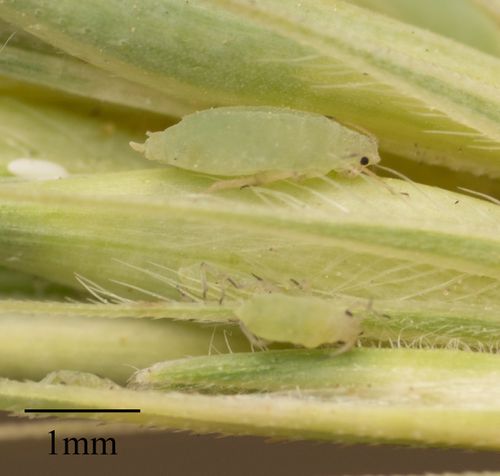Russian wheat aphid (Diuraphis noxia)
Biology and life history: Russian wheat aphid is a small, pale- or lime-green aphid with a football-shaped body. Unlike other cereal aphids, its legs, antennae, and cornicles are short as is a tail-like structure above the cauda (a tail-like process that is common in aphids). It migrates to cereal crops from other grasses in the summer. Although sexual reproduction has been reported in other continents, in North America, Russian wheat aphid reproduces mainly asexually (giving birth to live daughters), as only females have been found here.
Host plants and crop damage: The host range of Russian wheat aphid is wide including cereal crops such as wheat, barley, triticale, oats and grasses such as wheat grasses, bromegrasses, wild ryes and jointed goatgrass. Wild grasses provide alternative host to this aphid specially between the harvest and emergence of cereal crops. Like cereal grass aphid and greenbug aphid, Russian wheat aphid injects toxic saliva into the plant while feeding, causing white elongated streak on leaves and stem. The infested leaves tightly curl up staying upright. Seed heads of affected plants can curl, reducing harvestable yield. Unlike many other aphids, Russian wheat aphid is a non-vector of plant viruses, although some reports indicate that it is a vector for brome mosaic virus in North America.
Management: Conservation of natural enemies might help controlling population of this aphid. Lady beetles, ground beetles, lacewings, spiders, hover flies, and parasitic wasps are commonly known natural enemies of aphids, but their effectiveness in controlling Russian wheat aphid has not been fully studied. Cultural control such as crop rotation as well as cultivating resistant cultivars help managing this pest. In areas with high Russian wheat aphids, regular field monitoring and survey is necessary, especially looking for the white stripes on plant to help determine the threshold level for insecticide treatment.

